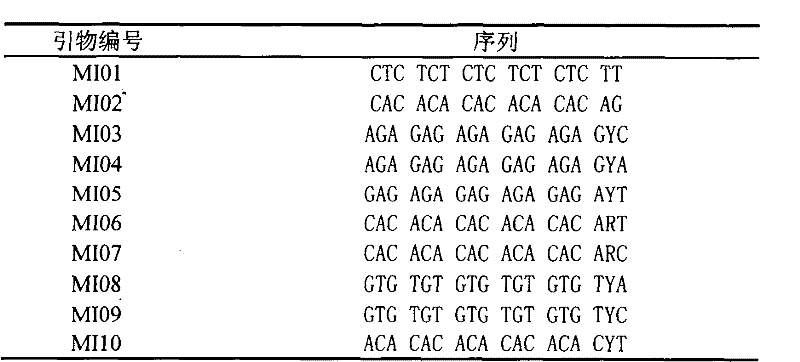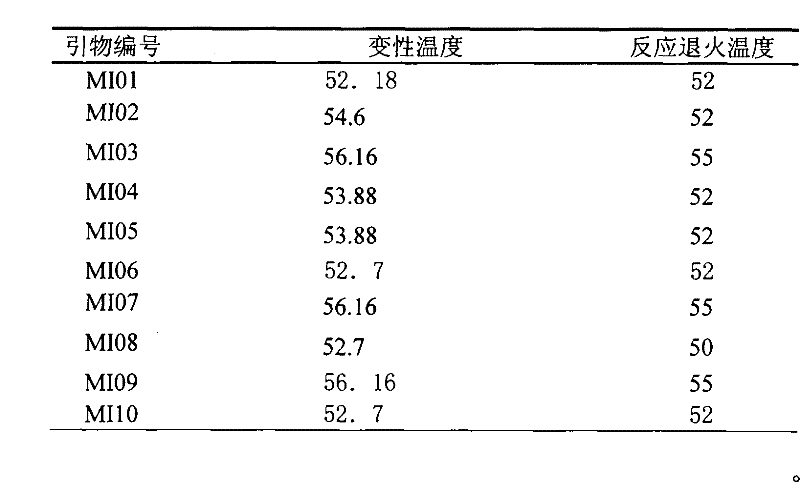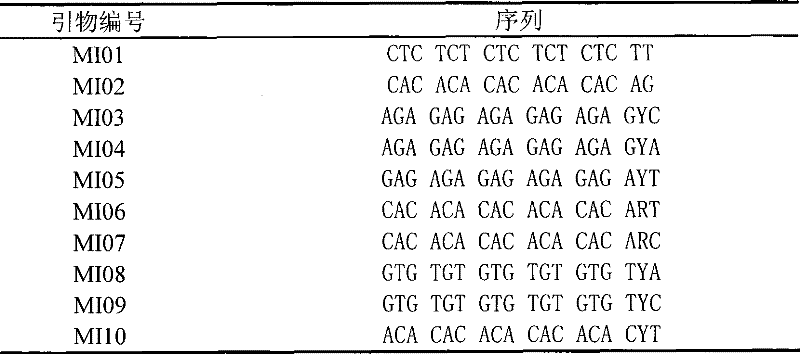Simple repetition sequence primer for moerella iridescens
A simple repeating sequence, rainbow technology, applied in recombinant DNA technology, microbial determination/inspection, biochemical equipment and methods, etc., can solve the problems of complex operating conditions, low annealing temperature, high cost, and reduce enzyme digestion steps, The effect of high annealing temperature and low cost
- Summary
- Abstract
- Description
- Claims
- Application Information
AI Technical Summary
Problems solved by technology
Method used
Image
Examples
Embodiment 1
[0037] Example 1. The simple repeat sequence primer of the rainbow clam, which is a primer set composed of the following 10 primer sequences:
[0038]
Embodiment 2
[0039] Example 2. The application of the simple repeat sequence primer of rainbow clam, its steps are as follows,
[0040] 1.10 Synthesis of standard primers
[0041] 10 primers in the table of Example 1 were synthesized by a bioengineering company, each 2 OD.
[0042] 2. Extraction of the genome of the rainbow clam
[0043] Collect 30 samples of wild populations of Rainbow clams (the number of populations is not limited, but at least two), and bring fresh samples back to the laboratory, and use the standard phenol-chloroform method to extract genomic DNA. Specific process and reagent formula, the genomic DNA of rainbow clam adopts SDS lysate formula: 10mmol / LTris.Cl (pH=8.0), 0.1mmol / L EDTA (pH=8.0), 0.5%SDS, the step of extraction is to take Put 50mg of muscle tissue of Rainbow clam, grind it into fine powder in liquid nitrogen, put it into a 2.0ml centrifuge tube, add 600μl of SDS tissue lysate, put it in a water bath shaker at 55°C, and add 10μl of proteinase K after ly...
Embodiment 3
[0053] Example 3. The application of the simple repeat sequence primer of rainbow clam, its steps are as follows,
[0054] 1. Extract the genomic DNA of the breeding line of P.
[0055] (1) SDS lysate formulation: 10 mmol / L Tris.Cl (pH=8.0), 0.1 mmol / L LEDTA (pH=8.0), 0.5% SDS.
[0056] (2) Step: Take 50 mg of muscle tissue from the legs of the rainbow clam, grind it into a fine powder in liquid nitrogen, put it into a 2.0ml centrifuge tube, add 600 μl of SDS tissue lysate, and put it in 55°C Water bath shaker, after 1 hour of lysis, add 10 μl of proteinase K (20 mg / ml), continue lysis for 3 to 4 hours, then take out the centrifuge tube and flick the bottom of the centrifuge tube with your fingers, let the unlysed tissue fully contact with the lysate, and make the tissue Cells can be fully lysed;
[0057] After lysis, add 600 μl Tris saturated phenol to each centrifuge tube, shake gently, invert 45-55 times, and let stand at room temperature for 10-15 minutes;
[0058] 120...
PUM
 Login to View More
Login to View More Abstract
Description
Claims
Application Information
 Login to View More
Login to View More - R&D
- Intellectual Property
- Life Sciences
- Materials
- Tech Scout
- Unparalleled Data Quality
- Higher Quality Content
- 60% Fewer Hallucinations
Browse by: Latest US Patents, China's latest patents, Technical Efficacy Thesaurus, Application Domain, Technology Topic, Popular Technical Reports.
© 2025 PatSnap. All rights reserved.Legal|Privacy policy|Modern Slavery Act Transparency Statement|Sitemap|About US| Contact US: help@patsnap.com



